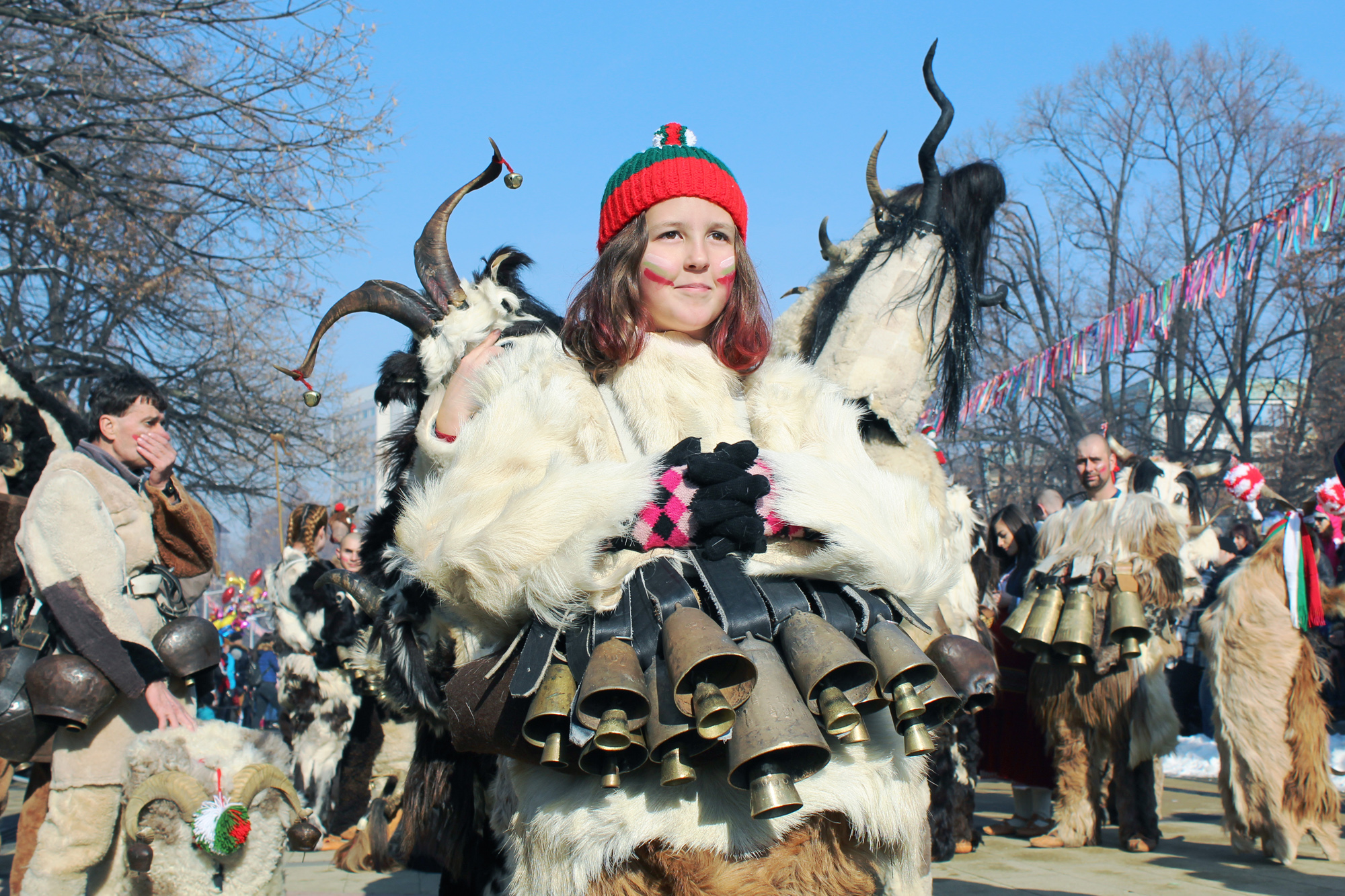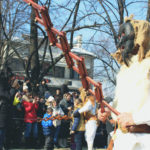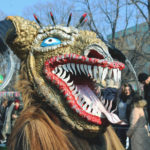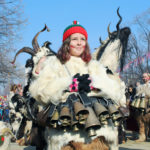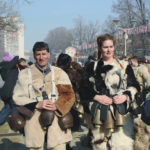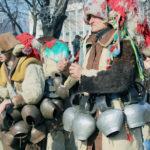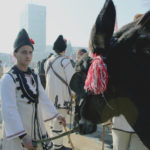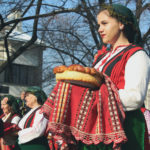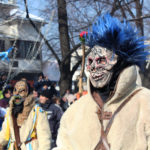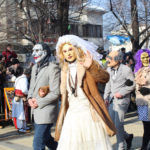Surva Festival: a lens on Bulgarian folklore
At first glance, Pernik may be far from being an attractive place with its soviet-style blocs, smoky industries and the thick layer of smog that overhangs it. Nevertheless, this town, located south-west of Sofia just 50 km far from the Serbian border, holds something magical and fascinating.
Every year, on the last Saturday and Sunday of January, Pernik becomes the scenario of the “Surva”: the biggest masquerade games of the entire Balkan peninsula. A unique immersion into the customs and traditions of different ethnographic regions of Bulgaria and the world.
From 26th to 28th January 2018, Pernik welcomed a new edition of Surva Festival attracting visitors from all over the globe. The popularity of this Slavic carnival grows year after year. According to official media, this last edition set new records of participation: over a hundred local and foreign groups with 7,000 members in the parades and a crowd of 300,000 spectators estimated. As usual, the festival counted also with the presence of members of the Bulgarian government and the Federation of European Carnival Cities (FECC). The(Y) Volunteers team had the privilege of being present and followed the celebrations closely, accompanied by the volunteers of the local NGO Aksels.
Surva folk feast: its roots and cultural meaning
Surva’s masquerade games, whose origins date back to the ancient pagan era, have been preserved until today characterizing the contemporary Bulgarian folklore. Kalin Vitanov, representative of the group from Leskovets village, explained that, over the centuries, the Surva absorbed and amalgamated a mixture of rituals, transforming itself into what Henry Ferdinand Van Der Kroon, President of FECC and honorary citizen of Pernik, defined as “the biggest folk festival in Europe”.
The 12 days between Christmas and Epiphany have a special significance in the Bulgarian Folk Calendar. These are the so-called “Dirty Days” (mrusnite dni or poganite dni), when the earth and sky were believed to be “unchristened”, and when evil spirits of all kinds were particularly active. These days are associated with the rituals performed by the Survakari -the Kukeri of Western Bulgaria-, men dressed in elaborate suits of fur and ribbons, feathers and beads to symbolize folkloric ritual monsters. In the villages of northwestern Bulgaria, specifically, these rituals are held between 13th and 14th January, the New Year’s day according to the Julian calendar.
In the earliest surviving accounts of the ritual –and in those towns and villages with the most loyally observed traditions– the Survakari usually start their work as early as dawn. They dance through village streets delivering health, happiness and a bountiful harvest year. They visit families too, letting themselves into homes in order to perform blessings. In some traditions, these “home invasions” take place in the morning, while in other communities are performed after dark, as the story goes, so “the sun would not catch them on the road.”
Lilly Georgieva, Chairperson of the local NGO Aksels, also pointed out that this authentic ritual is something different from the festival celebrated nowadays and she recalled some memories from her village Meshtitsa:
“In a small village, with around 900 people, it tooks around 20 hours. They go to every single house. I remember it from my childhood. They used to wear this heavy bells on them, that could weigh up to 50 kg, and to keep themselves warm with movement and spirits during all the night. It is very prestigious to give the group your own rakia. The ritual implemented in the villages is still very authentic and pure, far from commercial interests.”
An important part of the ritual is the implementation of a survakar wedding with a bride and groom, gypsies and musicians, a priest, a dancing bear and its trainer, mothers- and fathers-in-law and an army of wedding guests. All these characters are traditionally played by men – even the bride.
The group is led by a chieftain known as the Byulyukbashiya -a term that might come from Turkish and likely adopted during the Ottoman occupation-. His role is to play the whistle so the members can synchronize the movements and the zvanchari (bell-ringers) the sounds of their bells.
In each home they enter, the priest, accompanied by the owner, conducts a wedding ceremony, blessing everyone and everything beneath the roof. Meanwhile, the zvanchari jump and roll making a tremendous racket. When they end up with the expulsion of evil, they receive gifts such as rakia, walnut, bread, oranges or apples. Sometimes coins are offered too, which are usually considered as a donation towards the next year’s costumes.
Afterwards, the Survakari gather into the streets to perform their main ritual: a public wedding ceremony that gives way to drinking, dancing and widespread festivities. In some versions of the ceremony, Survakian fires are lit and participants leap through the flames in order to purify themselves, body and soul. This ancient ritual has been kept alive and performed until the present day.
Presumably, the etymology of the term Surva might find its roots in these rituals. Actually, “Surva!” was the greeting that the Survakari kept shouting to householders. According to another hypothesis, the term may refer to the adjective surov (raw) denoting life’s energy, health and prosperity. Some scholars even made reference to the Sanskrit word suria meaning sun and a Slavic god of the sun, Sur, venerated during this part of the year.
Masks and costumes play a central role in the Surva. A detailed description of them is given by the historian Mercia MacDermott:
“The costumes and masks are very varied. In some places, the survakari are clothed from head to foot in shaggy goat and sheep skins, and have naturalistic masks incorporating the heads and horns of actual animals such as rams, goats and hares, while in others, the masks consist of tall cones of fur, as much as a yard high, with tufts of hair on top or they may take more fantastic forms, with formidable teeth and beaks. Especially worthy of mention are the “faces” (likove) of the Pernik district.
Here, the survakari masks are surmounted by enormous head-dresses, often taller than the men wearing them and consisting of square, elliptical or pyramidal frames, covered with fur and feathers – even complete bird wings – and sometimes adorned with whole stuffed bird and animals as large as lambs, eagles and foxes. The Pernik survakari themselves wear costumes made shaggy with numerous long strips of red material. All survakari, irrespective of differences in dress, carry wooden weapons and wear bells around their waists.”
The mask, according to folklore beliefs, is a protection from the harmful influence of impure powers. Some masks have two sides. One of the sides represents a good face, and the other a scary face. Such masks are a symbol of good and evil, which exist together in the world. Also, the colors mark important symbolism of their costumes, as red stands for fertility, reviving the nature, the sun and the fire. The black color is a symbol of Mother Earth and the white is the color of light and water. Mask preparation is a ritual itself, as Lilly Georgieva tells:
“It’s very difficult to prepare this big masks. In our village of Meshtitsa, it is popular to use wood, leather, feathers, sheepskin, fur, beads and ribbons. In order to collect the materials needed, you need quite a lot of animals and it may take years. A good mask is used from 7 to 10 years. […] Also kids are taking part in this ritual, in our village of Meshtitsa: we have 3 year-old boys with real leather and fur masks. And this tradition is not only kept alive and transferred from generation to generation, but also reinvented with the creativity of young people. In the past, it was a must to use only natural materials in the making of. Nowadays, there are more synthetic ones. ”
With gender emancipation, the tradition is changing. As Lilly Georgieva explains:
“In the past, until mid 90’s, in our Surva tradition and carnival only men were allowed to participate. Every boy was supposed to participate in the ritual to become an adult man, without this step he couldn’t be married. But in the last five or six years, girls also participate in the village performances on 14th January.”
Surva today: a world-renowned celebration
The official festival of masquerade games was organized for the first time in 1966 by the Municipality of Pernik, but only 27 editions had been held so far. For a long period, the festival was celebrated every 4 years until it progressively reached its annual frequency, in 2008. In its very beginnings, there were only local groups participating and, since the 80’s, foreign ones were finally invited to take part.
The Surva gained the status of “international event” in 1985 and, 10 years later, the town of Pernik joined the Federation of European Carnival Cities (FECC) – the world’s largest body dedicated to the promotion and preservation of people’s festivals and parades-. In 2009, Pernik has been also awarded European Capital of Sourvakar and Mummer traditions by the FECC.
Moreover, since 2015, the Surva folk feast of Pernik region is on the list of Intangible Cultural Heritage by UNESCO, along with the archaic dances and polyphonic singings known as Bistritsa Babi (2008), the Nestinarstvo fire-dancing rite (2009) and the carpet-making tradition of Chiprovtsi (2014). All forms of expression that bear witness to the rich and varied cultural mosaic that defines Bulgaria and position the country in the world heritage map.
Our special thanks to Lilly Georgieva, Petya Dimitrova and the volunteer team of the organization “Aksels” -Patricia, Beata, Francesco and Grzegorz- for their support and the work we did together.
Sources:
- www.surva.org
- www.ich.unesco.org
- www.bulgariaoggi.com
- www.bnr.bg
- Bulgarian Folk Costums (1998) – Mercia MacDermott (available online)

